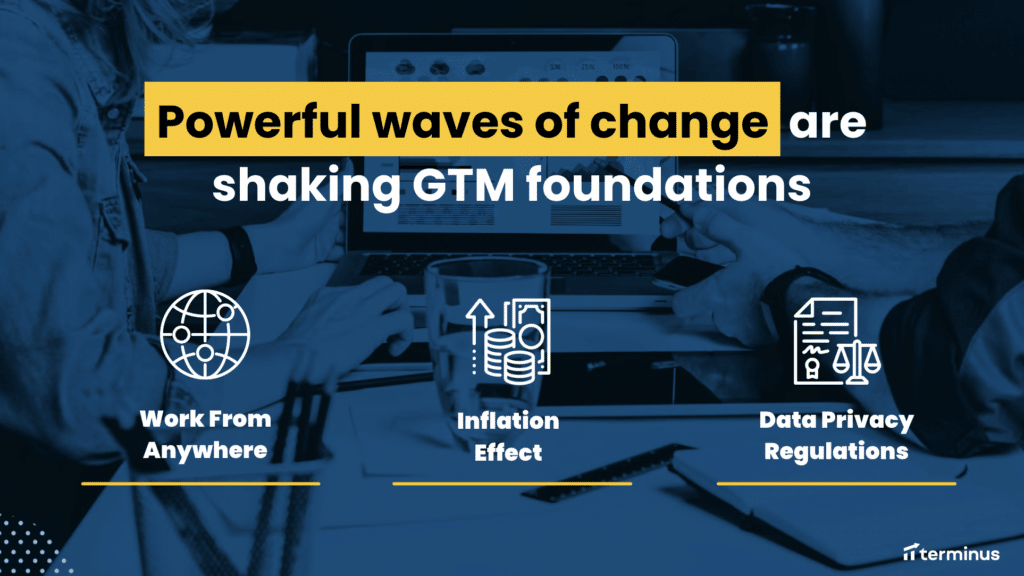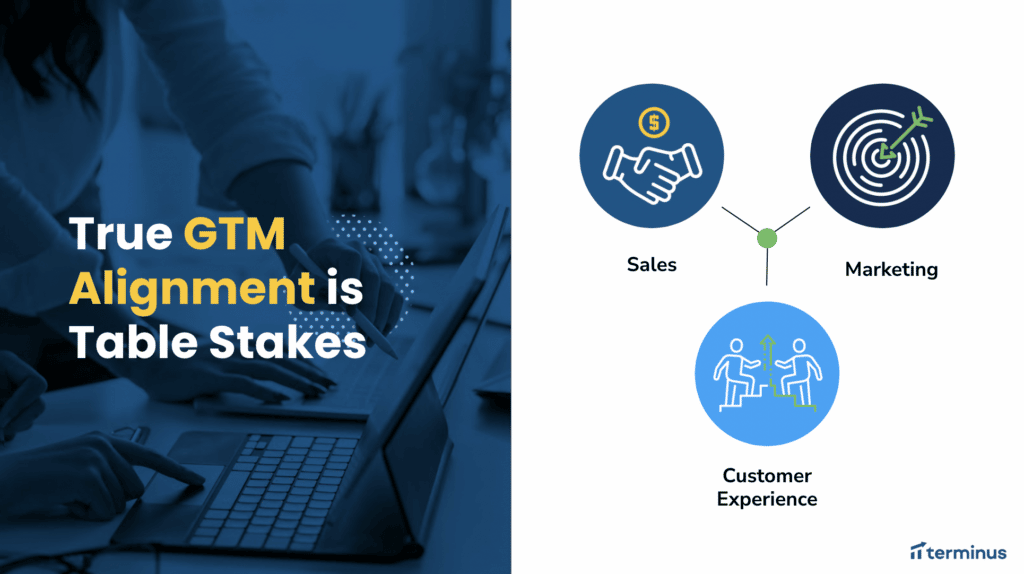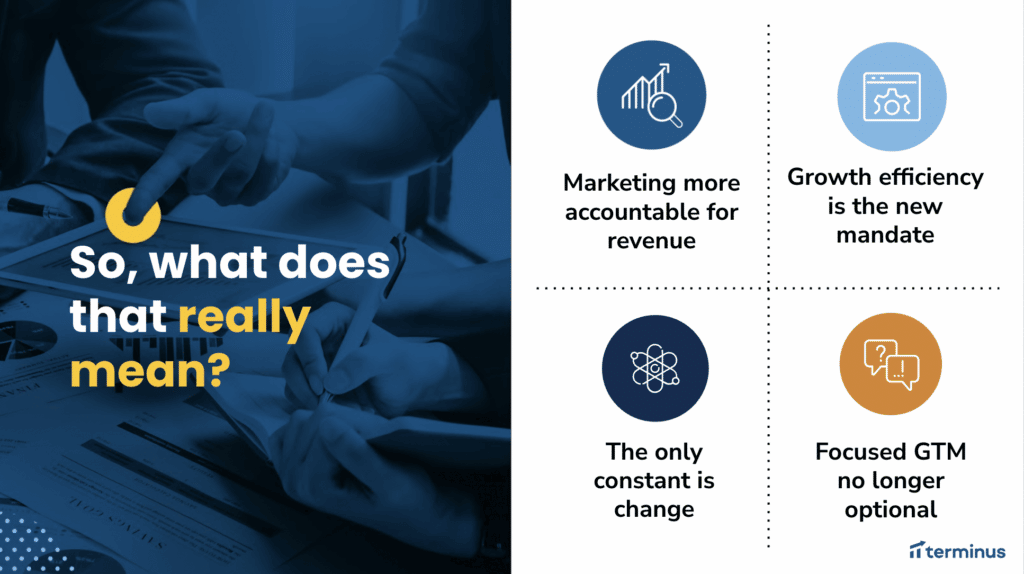Terminus CMO, Natalie Cunningham, recently gave a keynote address at B2BSMX in Boston. We’ve taken her talking points and spun them up into this blog to talk about how this time of change is a real opportunity for marketers. We hope you’ll continue the conversation with us.
Every marketer is scrambling. We fought our way through a global pandemic for which there was no marketing playbook and we saw a good chunk of our pipeline erased as in-person events were canceled, the virtual market became flooded with content, and we seemed to be up against a new socio-economic crisis each week.
After two years of turmoil, the game continues to change in 2022 in major ways:
- In-market buyers and decision makers are harder than ever to reach. They’re working from anywhere, they’re changing jobs at a more rapid and unpredictable pace.
- Our economy is struggling. We’re staring down a recession and every venture capitalist in the country is asking, “why does marketing spend so much money again?”
- Budgets are under scrutiny like we haven’t seen in more than a decade. And at the same time, costs (like ads on Google) are skyrocketing across industries.
On top of that, the near exit of third-party cookies is disrupting traditional digital advertising. We are feeling change in the very foundation of everything that B2B marketing and sales have known to be true for the last decade.

And so we’ve found ourselves here. Marketing and the entire go-to-market function that drives and grows revenue in B2B companies like yours is actually at an inflection point.
Is This an Opportunity? Heck Yeah. A Golden Opportunity.
Instead of talking about MQLS, web traffic, “top of funnel volume,” and even pipeline creation, we’re now in an environment primed for marketing, sales, and customer experience teams to have real business conversations about revenue impact, efficiency, and predictability.
“We’ve been talking about marketing as a revenue driver for a long time,” says Terminus CMO Natalie Cunningham. “The rubber is finally meeting the road. In this economy, with changes in buying behavior, channel performance, and budget scrutiny, marketing has no option but to shift their primary KPI from pipeline creation to revenue generation. It’s time to put a padlock on our seats at the revenue table before we get relegated back to the kiddie table with vanity metrics and making things pretty.”
One of the reasons this is becoming more and more critical is the sunset of the “growth at all costs” model.
- Marketing teams can no longer hit their numbers by brute force and an inflated media budget generating pipeline that we all know isn’t going to close.
- Sales teams can no longer hit their numbers by hiring more reps and waiting for marketing to feed them. Rep efficiency is key.
- Customer experience teams must have revenue accountability. Everyone touching a customer relationship, from first impression to advocacy must be focused on and incentivized by long-term customer success and, ultimately lifetime value.
It’s Time to Get Comfortable With Change
The interconnectivity of go-to-market and revenue performance is more critical than ever. How many times have you come up with a beautiful, strategic, perfectly orchestrated demand program only to have it fail because your audience was “anyone with a pulse,” your only differentiators were product features, and your CTA was “buy now?” Right. Far too many times.
“In the last year, I’ve seen more and more teams investing the time and energy into REAL focus, putting the ‘ideal’ in ICP,” says Cunningham. “A truly aligned GTM is absolutely table stakes now. It’s not even an advantage, it’s a requirement. It’s the price of entry in today’s changing market.”
“When I say True GTM Alignment here, what I mean is a full-fledged, top to bottom, C-suite to rep, priority and budget, strategy and activity-level alignment.” Terminus CMO, Natalie Cunningham

Obviously sales and marketing alignment is no new topic, but the addition of the Customer Experience team is key. True GTM alignment means that we’re focusing on those accounts that are not only most likely to close, but are most likely to be successful with us. In the SaaS universe, that means pulling product teams into your GTM alignment mix, too.
Keeping a finger on the pulse of the external market conditions and understanding the entire customer journey is an all-in effort. Leaders must also be able to look internally within the organization, understanding and influencing the customer experience, and in turn the product roadmap. It’s all of us. The GTM team must be “rowing in the same direction” at all times.

Now Is the Time for ABM to Join the Party
“Demand generation programs have a place. People are still going to come to your website. They’re still going to find you on Google. Yes, do those things. Optimize your site. Drive SEO value. Create valuable content,” cautions Cunningham. “What I’m suggesting—in today’s world—is that it’s time to call that the bare minimum and shift our budgets, resources, and strategic focus to ABM.”
The new mandate in B2B is revenue impact, efficiency and predictability. It’s time for marketers to focus on leaning into their ICP, creating deeply focused alignment across the go-to-market team and commit to an account-centric approach to driving and maintaining revenue.
To read more from Natalie and her thoughts on the state of B2B marketing and GTM alignment, we’ve listed some resources below:
- If ABM’s at an inflection point, where to next? The way ahead according to Terminus CMO Natalie Cunningham, an article from Diginomica
- Economic Downturn Ahead: 4 Ways to Trim Your Martech Stack, an article from CMSWire
- B2BSMX Day 3 Recap: It’s Time For Real Conversations Around Revenue Generation, Efficiency & Predictability, an article from Demand Gen Report
Natalie’s LinkedIn profile can be found here.